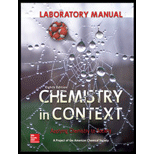
Concept explainers
Use the bond energies in Table 5.1 to calculate the energy changes associated with each of these reactions. Then, label each reaction as endothermic or exothermic.
- a. 2 H2(g) + CO(g) → CH3OH(g)
- b. H2(g) + O2(g) → H2O2(g)
- c. 2 BrCl(g) → Br2(g) + Cl2(g)
(a)
Interpretation:
The energy changes have to be calculated, the reaction is exothermic or endothermic has to be labelled.
Concept introduction:
Endothermic reaction: When the heat energy was absorbed by the system from the surrounding is called endothermic reaction.
Exothermic reaction: When heat energy or light energy was unconfined to the surrounding from the system is called exothermic reaction.
Net energy change is calculated from the difference between the total energy absorbed in breaking bonds and total energy released in forming bonds.
Explanation of Solution
The given is shown below,

Bonds broken in the reactants are given below:
Bonds formed in the products are given below:
The overall energy change is negative, therefore, the reaction is an exothermic reaction.
(b)
Interpretation:
The energy changes have to be calculated, the reaction is exothermic or endothermic has to be labelled.
Concept introduction:
Endothermic reaction: When the heat energy was absorbed by the system from the surrounding is called endothermic reaction.
Exothermic reaction: When heat energy or light energy was unconfined to the surrounding from the system is called exothermic reaction.
Net energy change is calculated from the difference between the total energy absorbed in breaking bonds and total energy released in forming bonds.
Explanation of Solution
The given is shown below,

Bonds broken in the reactants are given below:
Therefore,
Bonds formed in the products are given below:
Therefore,
The overall energy change is negative, therefore, the reaction is an exothermic reaction.
(c)
Interpretation:
The energy changes have to be calculated, the reaction is exothermic or endothermic has to be labelled.
Concept introduction:
Endothermic reaction: When the heat energy was absorbed by the system from the surrounding is called endothermic reaction.
Exothermic reaction: When heat energy or light energy was unconfined to the surrounding from the system is called exothermic reaction.
Net energy change is calculated from the difference between the total energy absorbed in breaking bonds and total energy released in forming bonds.
Explanation of Solution
The given is shown below,

Bonds broken in the reactants are given below:
Therefore,
Bonds formed in the products are given below:
Therefore,
The overall energy change is negative, therefore, the reaction is an exothermic reaction.
Want to see more full solutions like this?
Chapter 4 Solutions
Laboratory Manual Chemistry in Context
Additional Science Textbook Solutions
Campbell Biology: Concepts & Connections (9th Edition)
Chemistry: Structure and Properties (2nd Edition)
Organic Chemistry (8th Edition)
- What is the final product when D-galactose reacts with hydroxylamine?arrow_forwardIndicate the formula of the product obtained by reacting methyl 5-chloro-5-oxopentanoate with 1 mole of 4-penten-1-ylmagnesium bromide.arrow_forwardIn the two chair conformations of glucose, the most stable is the one with all the OH groups in the equatorial position. Is this correct?arrow_forward
- please help me with my homeworkarrow_forwardhelparrow_forwardThe temperature on a sample of pure X held at 1.25 atm and -54. °C is increased until the sample boils. The temperature is then held constant and the pressure is decreased by 0.42 atm. On the phase diagram below draw a path that shows this set of changes. pressure (atm) 2 0 0 200 400 temperature (K) Xarrow_forward
- QUESTION: Answer Question 5: 'Calculating standard error of regression' STEP 1 by filling in all the empty green boxes *The values are all provided in the photo attached*arrow_forwardpressure (atm) 3 The pressure on a sample of pure X held at 47. °C and 0.88 atm is increased until the sample condenses. The pressure is then held constant and the temperature is decreased by 82. °C. On the phase diagram below draw a path that shows this set of changes. 0 0 200 temperature (K) 400 аarrow_forwarder your payment details | bar xb Home | bartleby x + aleksogi/x/isl.exe/1o u-lgNskr7j8P3jH-1Qs_pBanHhviTCeeBZbufuBYT0Hz7m7D3ZcW81NC1d8Kzb4srFik1OUFhKMUXzhGpw7k1 O States of Matter Sketching a described thermodynamic change on a phase diagram 0/5 The pressure on a sample of pure X held at 47. °C and 0.88 atm is increased until the sample condenses. The pressure is then held constant and the temperature is decreased by 82. °C. On the phase diagram below draw a path that shows this set of changes. pressure (atm) 1 3- 0- 0 200 Explanation Check temperature (K) 400 X Q Search L G 2025 McGraw Hill LLC. All Rights Reserved Terms of Use Privacy Cearrow_forward
 ChemistryChemistryISBN:9781305957404Author:Steven S. Zumdahl, Susan A. Zumdahl, Donald J. DeCostePublisher:Cengage Learning
ChemistryChemistryISBN:9781305957404Author:Steven S. Zumdahl, Susan A. Zumdahl, Donald J. DeCostePublisher:Cengage Learning Chemistry & Chemical ReactivityChemistryISBN:9781133949640Author:John C. Kotz, Paul M. Treichel, John Townsend, David TreichelPublisher:Cengage Learning
Chemistry & Chemical ReactivityChemistryISBN:9781133949640Author:John C. Kotz, Paul M. Treichel, John Townsend, David TreichelPublisher:Cengage Learning Chemistry & Chemical ReactivityChemistryISBN:9781337399074Author:John C. Kotz, Paul M. Treichel, John Townsend, David TreichelPublisher:Cengage Learning
Chemistry & Chemical ReactivityChemistryISBN:9781337399074Author:John C. Kotz, Paul M. Treichel, John Townsend, David TreichelPublisher:Cengage Learning General Chemistry - Standalone book (MindTap Cour...ChemistryISBN:9781305580343Author:Steven D. Gammon, Ebbing, Darrell Ebbing, Steven D., Darrell; Gammon, Darrell Ebbing; Steven D. Gammon, Darrell D.; Gammon, Ebbing; Steven D. Gammon; DarrellPublisher:Cengage Learning
General Chemistry - Standalone book (MindTap Cour...ChemistryISBN:9781305580343Author:Steven D. Gammon, Ebbing, Darrell Ebbing, Steven D., Darrell; Gammon, Darrell Ebbing; Steven D. Gammon, Darrell D.; Gammon, Ebbing; Steven D. Gammon; DarrellPublisher:Cengage Learning Introductory Chemistry: A FoundationChemistryISBN:9781285199030Author:Steven S. Zumdahl, Donald J. DeCostePublisher:Cengage Learning
Introductory Chemistry: A FoundationChemistryISBN:9781285199030Author:Steven S. Zumdahl, Donald J. DeCostePublisher:Cengage Learning Chemistry for Engineering StudentsChemistryISBN:9781337398909Author:Lawrence S. Brown, Tom HolmePublisher:Cengage Learning
Chemistry for Engineering StudentsChemistryISBN:9781337398909Author:Lawrence S. Brown, Tom HolmePublisher:Cengage Learning





